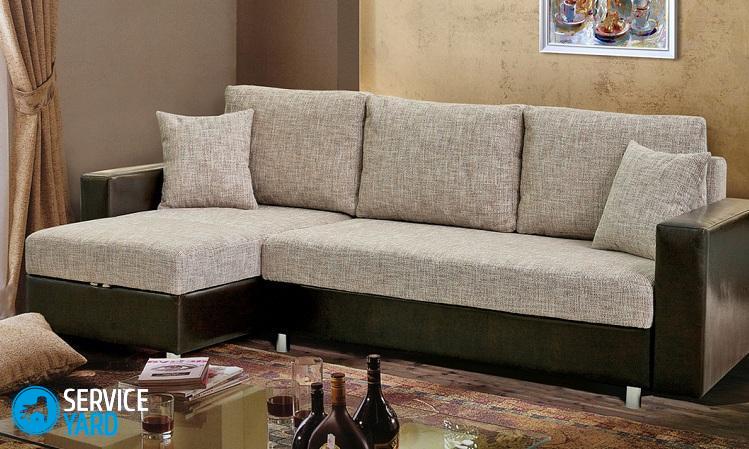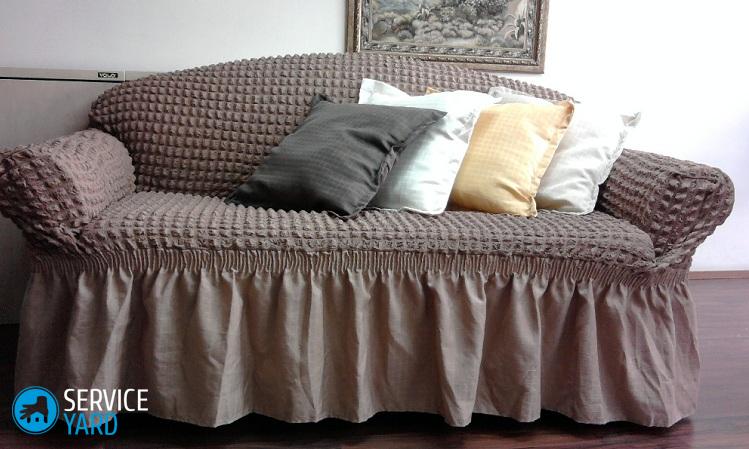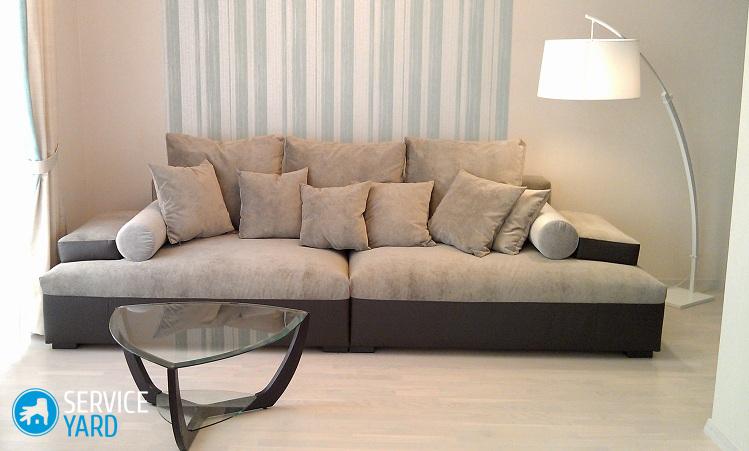How to sheathe a sofa?

Agree, no matter how hard we try to keep our furniture clean and tidy, sometimes you just have to face it and admit to yourself that over time the furniture becomes unusable. Sofas are no exception. Where we spend a lot of time with people close to us, receiving guests, playing with children, I would like to see everything in an updated and good condition. A sofa is a type of furniture that is often used in everyday life, therefore upholstery quickly goes out of operation, and deformation of the filler itself is also possible. Have you ever spilled tea or coffee on the sofa? Perhaps the children, playing, accidentally stained, and you did not know how to fix the situation. These examples are just a small part of what can affect the appearance of the sofa. But there is a way! In this article we will tell you how to sew a sofa with your own hands.
to contents ↑Instruments
All work begins with planning and preparing for the process itself. If you want to independently sew a sofa, without the help of specialists, then you should perform all the actions in a certain order. This will eliminate possible errors.
Initially, you need to take care of the availability of the necessary tools and materials. So, for work you will need such tools:
- Construction stapler with staples.
- Phillips and flat head screwdrivers.
- Building braces.
- Wallpaper knife, scissors.
- Hammer.
- Threads for furniture.
- Chalk and needle
- Drill.
- Nail clipper.
- Screwdriver.
- Self-tapping screws.
- PVA glue.
- Upholstery fabric.
- Furniture tape.
- Braid or piping.
Choose fabric
After you have decided on the filler, you should pay attention to the material for the constriction of the sofa. The choice is great enough. Covering the sofa with your own hands with the help of a fabric is a rather painstaking and responsible process. High-quality, reliable and beautiful material is the key to an excellent result at the end of the work.
For these purposes, you can use the following common coatings:
- Tapestry - is a dense, noble fabric, which is endowed with dust-repellent properties.
Important! Ideal for furniture in the interior in retro style.
- Jacquard is an artificial silk that has a double-sided pattern. The material is incredibly beautiful, so it looks very expensive and solid. Contamination from this fabric is removed without much effort.
- Flock is a fabric that is made from a natural or artificial base. The material is velvety in a small volume, due to which it is extremely pleasant to touch. It can be cleaned both dry and wet.
Important! There is no trace left on such a surface, especially if you have pet pets.
- Velor - characterized by low pile and high strength. A big plus is that this fabric does not crease.
- Chenille - in terms of external indicators, it is largely similar to velor, but unlike it, the material has the highest quality scale. In addition to these signs, he has the ability to breathe, as well as slight hairiness.
- Artificial suede - this fabric according to its characteristics can be non-woven and woven. The material can be easily cleaned, it is easy to carry out wet cleaning with warm soapy water.
- Leather, in turn, can be both natural and artificial. The choice depends on the budget for upholstery restoration, as well as on your own preferences.The material is quite common in updating furniture and quite durable, practical to use.
Important! The downside is that the skin does not like the claws of animals.
Important Nuances
Ordinary fabrics that are used for sewing clothes are categorically not suitable for such finishing work. They are not completely durable and have low wear resistance.
When choosing a fabric for upholstering an old sofa, first you need to think about the functionality of the new:
- If the sofa is designed solely to sit on it, in other words for beauty, it is worth giving preference to a more dense and wear-resistant fabric with synthetic fibers.
- If you want to use the sofa only for sleeping, then it is better to choose a fabric based on natural fibers. Such an upholstery will allow the body to breathe, feel comfortable, which is important for a place of sleep and rest.
to contents ↑Important! Regardless of which material you choose, it is important to consider the following requirements:
- Strength.
- Easy to clean.
- Resistance to ultraviolet radiation.
- Environmental friendliness and safety.
- Attractive appearance.
Filler
In addition to the material for the constriction, you should choose the internal filler.
Polyurethane
In the modern market of fillers, the rightful leader is polyurethane foam, which can easily be bought at any hardware store at a very affordable price.
Important! When choosing a filler, preference should be given to polyurethane foam rather than foam rubber, since it is denser, does not lose its qualities to external loads for longer.
Foam rubber
If you have stopped on the purchase of foam rubber, it is important to pay attention to such characteristics:
- The required thickness of the foam used for the seat and back of the sofa should be 40 millimeters thick.
- For the sidewall of the sofa, you can use foam rubber of 20 millimeters.
- The density of the foam directly depends on for which element this filler is selected. For example, for a seat you need a higher density indicator, and for a back and armrests - a smaller one. Foam with a density of 46 units is ideal for the seat, and 30 units or more for the back of the sofa.
Important! It is the density of the foam that affects its life.
- Softness.
- Elasticity.
Important! Foam with a fairly low density deforms fairly quickly, especially on the upholstery of a sofa. Therefore, for such work, we recommend choosing a denser and more rigid material. But do not overdo it: too dense foam will be very uncomfortable in operation.
A synthetic winterizer is a durable material, and therefore it changes extremely rarely if everything is done correctly in the installation technique.
Synthetic winterizer
The synthetic winterizer will give your furniture ease and comfort. It is quite soft, but may eventually become lumpy.
to contents ↑Important! The pronounced smell of chemistry can tell you about the poor quality of this material.
Sofa device
Standardly, each sofa consists of the following parts:
- Back.
- Seats
- Armrests.
- The lower part of the sofa (king).
- Locks for fixing the back.
You need to know this to understand how to sew a sofa with your own hands.
to contents ↑Preparing an old sofa
To sheathe the sofa with our own hands, we:
- We completely free the wooden frame from nails, staples and completely worthless old fiberboard.
- Now you need to fix the plywood sheet on it by sticking foam on top.
- Next, you need to carefully measure the size of the seat and back, while not leaving a margin for allowances, but not cutting off extra centimeters.
- In order for the sofa to be extremely soft and resilient, it is necessary to lay the foam rubber in two layers: the bottom is hard and the top is soft.
Getting to work
When we have collected all the necessary materials and tools, purchased and ready for work, you can proceed to the sofa upholstery itself. First you need to carefully disassemble it into the main elements.
Furniture disassembly
Undoubtedly, before we sheathe the sofa, we need to make out the piece of our furniture. This can be done using special keys.
Important! Remember some of the nuances for yourself in this process. It can be easily disassembled, but assembled back - difficulties may arise. Therefore, this process requires special care and attention, which means that you should not quickly tear off the mounts if you could not do it the first time. Elements such as the back and sides of a sofa must be disassembled first.
Let's get acquainted with the step-by-step process of disassembling the sofa:
- Disassemble the seat.
- All fasteners must be marked and set aside in a specific place.
- If there are staples, you need to use an anti-stapler or a screwdriver.
- It is important to carefully handle the old upholstery - this is our stencil for the new.
- If there is a need to replace foam rubber or other material, then we are doing this work.
- We do an inspection of all the elements of the exposed structure (replacing the springs, pulling up the structural elements, gluing tears).
- We eliminate possible defects that are clearly visible.
Whether you should strictly follow this instruction or not is up to you. But we advise you to pay attention to this. In order to do everything correctly and not break the components of the sofa, you must follow this procedure:
- Remove the bolts that secure the armrests to the base.
- Remove the seats.
- Disconnect the king.
- Fold out the sofa and turn it over with its face to the floor.
- Remove the back.
- Remove all locks.
- Remove the seats.
- Remove the old fasteners - nails and staples.
- Remove old upholstery and filler.
- Remove the unit in the presence of faulty and broken springs.
Repair of the inside
The main part of the process consists of several stages. In order to properly fit the sofa, you should do everything step by step and extremely carefully.
It is necessary to start with the repair of the frame, that is, the spring block:
- With pliers, carefully unscrew the defective elements.
- We change the old springs to new ones.
- We insert the block into place and fasten with nails.
If there is a desire and time, then you can make the old springs more elastic with the help of foam parts or from an old blanket:
- Springs must be filled with pieces of chopped foam. If you chose an old blanket, then they cover the entire surface of the block from above and make seams using a needle with twine.
- Foam is pre-coated with glue so that the sheets of foam fit tightly and do not move with a shaker.
You can lay a synthetic winterizer on top of the foam - this will add volume.
Important! We want to note that sagging springs are not necessary to be removed, it is enough to stretch them - so they can still serve.
Sewing covers
It doesn’t matter how you make the sofa upholstery - leather or fabric. The following steps are pretty simple:
- On the seamy side up, we lay out a new fabric, on which we spread the elements of the old upholstery on top.
- Next, we fix everything with needles so that the elements do not budge.
- Circle all the constituent elements with chalk, not forgetting to leave allowances for the seams.
- We cut the fabric along the intended boundaries.
- We sew all patterns on a sewing machine.
We fit all the elements of the sofa
So, everything is ready for us, it remains only to upholstery the sofa with its individual constituent elements:
- We put on the covers already sewn by us - the back, seats and armrests.
- Those places where the new elements of the sofa will be fixed should be exactly where the old covers were placed.
- Using a construction stapler, we fix new covers.
Important! Please note that the material must be tensioned each time we drive in subsequent fasteners. This must be done so that the material lies evenly and smoothly, without creating an accordion effect. It is necessary to carry out work on the long side, gradually moving towards the short.
Finish assembly
Now we can only collect all the constituent elements in the reverse disassembly order, while it is important to pay attention:
- On coincidence marks.
- The fastening of the castle itself occurs first to the back, and only after that - to the seat and to the king.
- The first step is to mount the sidewalls, and then the armrests.
- At the end of all work, it is necessary to fix the wooden panels, having previously varnished them, if this is absolutely necessary.
Agree, all processes are quite simple and require only care and accuracy. Now you know how to sew a fabric sofa yourself, saving a good amount of money on this.
Important! Perhaps you will be puzzled with how to sew the armrest of the sofa with your own hands? The answer is simple. Follow the same pattern of actions that we used to haul all the constituent elements of this design. The only caveat is that wooden inserts can be on top of the armrest surface. If necessary, they must be replaced, fixed, varnished for strength.
Features of skin tightening
If you settled on the skin as a new material, then it is worth noting that this process of hauling is slightly different, more precisely, you need to take into account several important points:
- The sweeping process is completely excluded, since the needle is able to leave holes, scratches and cuts in the skin.
- All cut out elements for upholstery on the wrong side are fixed only with adhesive tape.
- First you need to lubricate the material with Vaseline, so as not to damage the skin during sewing - the foot of the sewing machine may leave marks.
- With the allowances that remained for the seams in the process of patterning, you also need to work. Putting them together, you can see that on the front side they can bulge a hillock, creating ugly bumps. Allowances for obtaining an even and smooth upholstery surface must be carefully separated and ironed through gauze folded in several layers.
to contents ↑Important! Seams will be more firmly fixed if braid is used during operation.
Stock footage
Now you know how you can replace the old upholstery with a new one without resorting to the help of specialists. It is important that this does not require a special workshop - all processes can be done at home. No frames and obsession in how to sheathe a sofa. It is only necessary to purchase the necessary materials, prepare a simple tool for work and proceed with a bit of painstaking work - fitting your favorite sofa. We wish you more inspiration, new achievements and the realization of your plan!
- How to choose a vacuum cleaner taking into account the characteristics of the house and coatings?
- What to look for when choosing a water delivery
- How to quickly create comfort at home - tips for housewives
- How to choose the perfect TV - useful tips
- What to look for when choosing blinds
- What should be running shoes?
- What useful things can you buy in a hardware store
- Iphone 11 pro max review
- Than iPhone is better than Android smartphones






